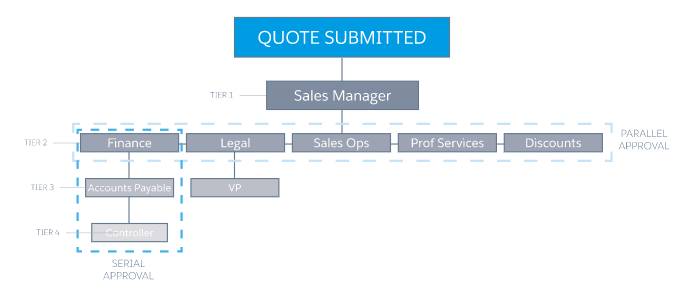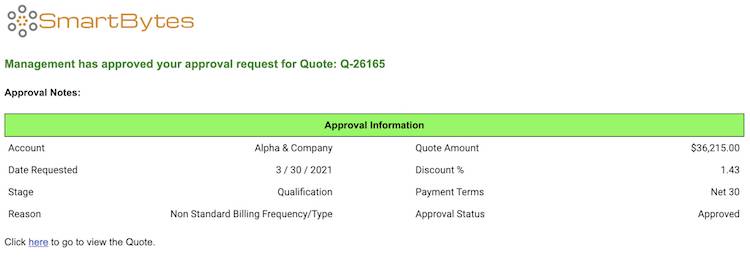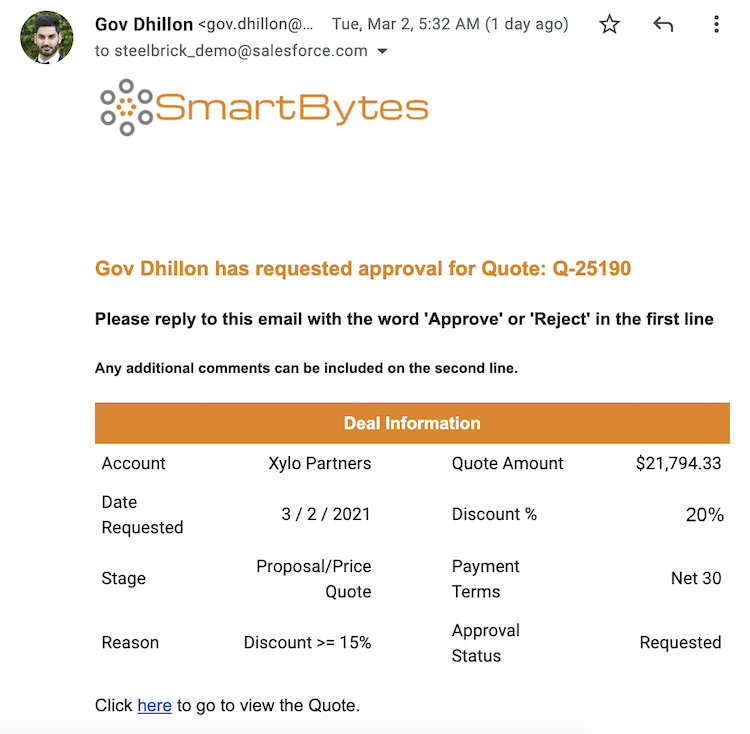Manage Approval Submissions and Responses
The standard Salesforce approval process works for a lot of common use cases. However, some businesses want an approval system that lets them customize their approval process with complex workflows. For example, they may require quotes to first receive an initial approval from a sales manager, then additional approvals from various members of the finance, legal, sales ops, and professional services departments. After the finance team approves the quote, the accounts payable representative and controller must approve it as well.

Managing an approval process with serial (sequential) and parallel (simultaneous) approvals is challenging for many systems. Businesses use Advanced Approvals to set up complex approval paths while providing their sales reps with an easy approval management system. As a sales rep, all you need to do is click the Submit Approval button on your record and wait for a response from the approval managers. If you’re an approval manager, you’ll get an email whenever a submitted record meets a predefined approval rule and its conditions.
Your Advanced Approvals admin sets up approval rules for your org. For example, they may configure a rule to send out an approval request email when a submitted quote’s net total is over $100,000. Approval rules can be configured for Salesforce opportunities and Salesforce CPQ objects. As a sales rep or approval manager, you don’t need to worry about the rules or conditions. If you’re a sales rep, you preview, submit, and recall approvals, while managers just need to approve or reject a sales rep’s request.
Previewing and Submitting Approvals
When you submit an approval, Salesforce runs a series of evaluations based on the approval rules that your Salesforce admin configured for the object you’re submitting. For example, a quote might have an approval rule requiring sales manager approval for discounts over 10%. If you submit a quote with a discount of 15%, your sales manager gets an approval request email and decides whether or not to approve your quote.
If you want to see what types of actions require an approval and who needs to approve the action, click the Preview Approval button. Let’s say you clicked Preview Approval for one of your opportunities and saw the following approval chart.

This approval chart shows that up to five people would evaluate your quote based on its configuration. Approval reviews on the same step happen independently of other approvals on the same step. If your quote contains a custom product, nonstandard terms, and a discount of 15%, Ernest, Lynn, and Mina can all review your approval request regardless of whether anyone else in Approval Step 1 has started reviewing it yet. All approvers on all steps must approve the request before Advanced Approvals considers it finally approved. We call approvals on the same step parallel approvals.
Serial approvals occur when one user must authorize an approval before the approval request passes on to another user. If your quote has a discount of 35%, Mina gets the email first. If she approves it, Serggio gets an email and must approve before the CEO receives the final email.
Approvers and Approver Groups
The approver record represents a single user, called an approver, or a group of users, called an approver group. If your approval request goes to an approver group, all members of the group must approve it before you receive your approval response email. You’ll often see approver groups represented in your Preview Approvals chart by their team name, such as Finance or Professional Services.
Approval Responses
Once an approver receives an approval request email, they either approve or reject it via email or the User interface. You’ll then receive an email showing their decision.


If someone rejects your approval, continue working on your record before submitting it again. Depending on how your admin configured your org’s approval processes, you may or may not need to resubmit your request to users who already approved it in your previous attempt. We cover the resubmission process more in a later module.
Once every approver in your approver chart has approved your submission, you then move forward with your sales process.
Recalling an Approval
If you want to edit a record that you sent for approval before any approval managers have approved it, click Recall on your approval detail page. This action changes the status of the submitted record from Pending or Approved to Recalled, and managers can no longer approve or reject it. When you resubmit a recalled approval, it goes back to the approval chain.
The Approval Record
When you submit a record, such as a quote or opportunity, for approval, Salesforce creates an approval record related to the record that you submitted. Let’s look at the most important approval fields that you’ll work with.
- Status
- Assigned To
- Approved By
- Rejected By
- [Source object field]
Approving or Rejecting an Approval Request
If an Advanced Approvals admin assigns you as the approver for an approval rule, you receive an email when the rule meets one or more of its approval conditions. The email layout will vary based on how the admin set up the email template, but most emails will contain some basic information about the record sent for approval and which field or fields require your attention.

In this example, an approval manager received a request to approve a quote. The request went out because the submitted quote’s discount percentage was greater than the approval rule’s condition of 15%.
The email template is styled so that the approver sees the name of the user who submitted the request, and the ID of the object sent for approval. A table shows important fields and values pulled from the object. A link at the bottom of the email allows the approver to open the object in Salesforce.
Your approval admin is also able to configure approval emails to recognize keyword responses to automate the approval response process in Salesforce. In this example, you can respond with either Approve or Reject. If you respond with Approve, the sales rep receives an email indicating that you approved their submission. Next, Advanced Approvals changes the approval record’s status from Requested to Approved. If you respond with Reject, Advanced Approvals sends a rejection email and then changes the approval record’s status from Requested to Rejected.